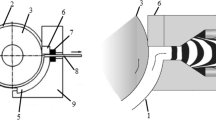Abstract
The finite element method is a progressive tool for the development and optimization of technological modes of metal forming. However, in order to obtain correct simulation results, it is necessary to set the boundary conditions as accurately as possible. At present, design programs usually use friction laws that do not take into account the sliding velocity. As numerous studies show, the sliding velocity of a deformed metal on the tool surface has a significant influence on the formation process under certain conditions of the flow of the deformed material at the tool–workpiece interface. This article presents the results of experiments and calculations associated with the effect of contact friction on the parameters of upsetting with torsion.











Similar content being viewed by others
REFERENCES
Zibel’, E., Die Formgebung im bildsamen Zustande: Theoretische Grundlagen der technische Formgebungsverfahren, Verlag Stahleisen, 1932.
Levanov, A.N. Kolmogorov, V.L., et al., Kontaktnoe trenie v protsessakh obrabotki metallov davleniem (Contact Friction in Metal Processing Processes), Moscow: Metallurgiya, 1976.
Behrens, A. and Schafstall, H., 2D and 3D simulation of complex multistage forging processes by use of adaptive friction coefficient, J. Mater. Process. Technol., 1998, vols. 80–81, pp. 298–303. https://doi.org/10.1016/S0924-0136(98)00187-3
Becker, P., Jeon, H.J., Chang, C.C., et al., Modelling the friction interface in bulk forming processes, Fachtagung Umformtechnik, Chemnitz, 2003, Neugebauer, R., Ed., Zwickau, Germany: Wissenschaftliche Skripten, 2003, p. 179.
Behrens, B.-A., Bouguecha, A., Hadifi, T., and Mielke, J., Advanced friction modeling for bulk metal forming processes, Prod. Eng., 2011, vol. 5, pp. 621–627. https://doi.org/10.1007/s11740-011-0344-8
Jain, S.C. and Bramley, A.N., Speed and frictional effects in hot forging, Proc. Inst. Mech. Eng., 1968, vol. 182, no. 39, pp. 783–798. https://doi.org/10.1243/PIME_PROC_1967_182_059_02
Davoudi, M., Nejad, A.F., Koloor, S.S.R., and Petrů, Investigation of effective geometrical parameters on wear of hot forging die, J. Mater. Res. Technol., 2021, vol. 15, pp. 5221–5231. https://doi.org/10.1016/j.jmrt.2021.10.093
Widomski, P. and Gronostajski, Z., Comprehensive review of methods for increasing the durability of hot forging tools, Procedia Manuf., 2020, vol. 47, pp. 349–355. https://doi.org/10.1016/j.promfg.2020.04.280
Lee, K.J. and Lee, M.G., Pressure and sliding velocity dependent surface asperity based friction model: Application to springback simulation, IOP Conf. Ser. Mater. Sci. Eng., 2019, vol. 651, p. 012079. https://doi.org/10.1088/1757-899X/651/1/012079
Cillaurren, J., Galdos, L., Sanchez, M., Zabala, A., Saenz de Argandoña, E., and Mendiguren, J., Contact pressure and sliding velocity ranges in sheet metal forming simulations, ESAFORM 2021: 24th Int. Conf. on Material Forming, 2021. https://doi.org/10.25518/esaform21.426
Sigvant, M., Pilthammar, J., Hol, J., Wiebenga, J.H., Chezan, T., Carleer, B., and van den Boogaard, T., Friction in sheet metal forming: influence of surface roughness and strain rate on sheet metal forming simulation results, Procedia Manuf., 2019, vol. 29, pp. 512–519. https://doi.org/10.1016/j.promfg.2019.02.169
Waanders, D., Marangalou, J.H., Kott, M., Gastebois, S., and Hol, J., Temperature dependent friction modelling: The influence of temperature on product quality, Procedia Manuf., 2020, vol. 47, pp. 535–540. https://doi.org/10.1016/j.promfg.2020.04.159
Behrens, B.-A., Bouguecha, A., Luken, I., Mielke, J., and Bistron, M., Tribology in hot forging, Comprehensive Materials Processing, 2014, vol. 5, p. 211.
Petrov, P.A., Burlakov, I.A., Nguen, Kh.T., Application prospects of hybrid workpieces in engineering industry, Tekhnol. Met., 2021, no. 8, pp. 10–23. https://doi.org/10.31044/1684-2499-2021-0-8-10-23
Burlakov, I.A., Petrov, P.A., and Chong, B.W., Production of axially symmetrical billets made of titanium VT1-0 with isotropic properties, Tekhnol. Met., 2020, no. 10, pp. 52–57. https://doi.org/10.31044/1684-2499-2020-0-10-52-57
Behrens, B.-A., Bouguecha, A., Hadifi, T., and Mielke, J., Advanced friction modeling for bulk metal forming processes, Prod. Eng., 2011, vol. 5, no. 5, pp. 621–627. https://doi.org/10.1007/s11740-011-0344-8
Neumaier, T., Zur Optimierung der Verfahrensauswahl von Kalt-, Halbwarm- und Warmmassivumformverfahren, Dissertation, Universität Hannover, Düsseldorf: VDI Verlag, 2003.
Alasti, M., Modellierung von Reibung und Wärmeübergang in der FEM-Simulation von Warmmassivumformprozessen, PhD Thesis, Leibniz Universität Hannover, 2008.
Nagele, H., Simulation des Herstellungsprozesses präzisionsgeschmiedeter Zahnräder mit der Finite-Elemente Methode, Dissertation, Universität Hannover, Düsseldorf: VDI Verlag, 1995.
Behrens, B.-A., Alasti, M., Bouguecha, A., Hadifi, T., Mielke, J., and Schäfer, F., Numerical and experimental investigations on the extension of friction and heat transfer models for an improved simulation of hot forging processes, Int. J. Mater. Forming, 2009, vol. 2, p. 121. https://doi.org/10.1007/s12289-009-0618-2
Doege, E. and Bederna, C., Analysis of boundary stresses and temperatures in hot massive forming, Prod. Eng., vol. 3, no. 2, p. 89.
Bernhardt, R., Ein Beitrag zur experimentellen und numerischen Analyse lokaler Kontaktspannungen und Kontakttemperaturen in der Wirkfuge von Gesenkgravuren unter besonderer Beachtung des Randreibungsproblems, Dissertation, TU Freiberg, 1998.
Khenzel’, A. and Shpittel’, T., Raschet energosilovykh parametrov v protsessakh obrabotki davleniem. Spravochnik (Analysis of Power and Strength Parameters in Processes of Metal Forming), Moscow: Metallurgiya, 1982.
Grudev, A.I., Zil’berg, Yu.V., and Tilik, V.T., Trenie i smazki pri obrabotke metallov davleniem (Friction and Lubricants at Metal Forming), Moscow: Mashinostroenie, 1982.
http://qform3d.ru/files_ru/2008_0001_0.pdf. Cited September 12, 2021.
Author information
Authors and Affiliations
Corresponding author
Ethics declarations
The authors declare that they have no conflicts of interest.
Additional information
Translated by O. Pismenov
About this article
Cite this article
Petrov, P.A., Burlakov, I.A., Gladkov, Y.A. et al. Determining the Effect of the Sliding Velocity on Contact Friction under Upsetting with Torsion. J. Mach. Manuf. Reliab. 52, 120–128 (2023). https://doi.org/10.3103/S1052618823020061
Received:
Revised:
Accepted:
Published:
Issue Date:
DOI: https://doi.org/10.3103/S1052618823020061




